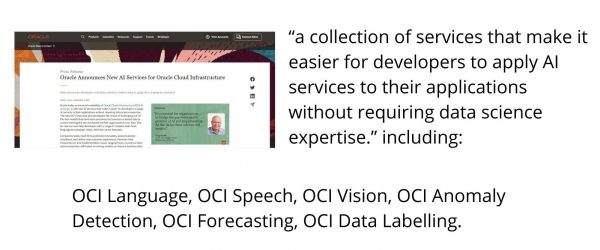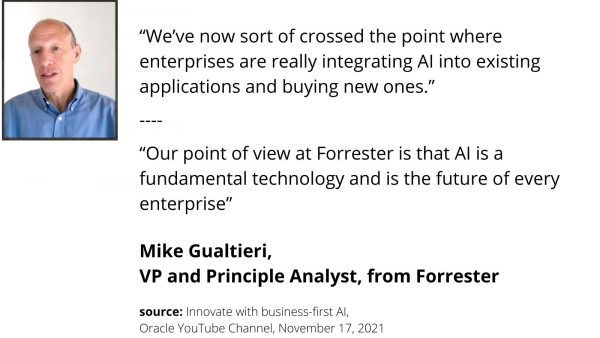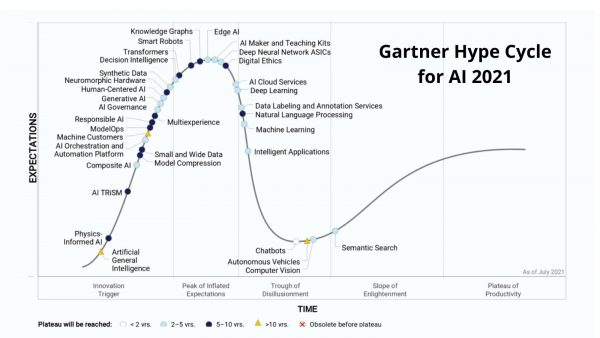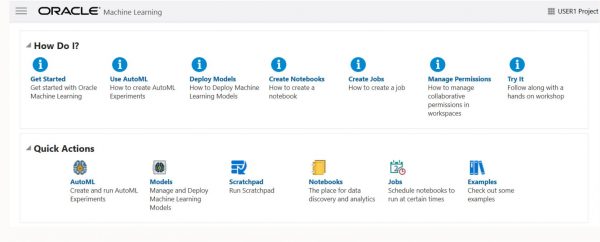In this interview, Adrian Png, Insum Senior Cloud Solutions Architect talks about recently launched Oracle AI services including pre-trained ML models, and AI’s role for the APEX developer. The interview was recorded in December 2021.
Interview Transcript
Marc Ruel: Hi everyone, and welcome to Insum interviews. Insum interviews is all about getting insight into technology trends of interest to the APEX developer. I’m your host Marc Ruel from the Insum marketing department, and today our guest is Adrian Png. Adrian is an Oracle ACE and Senior Cloud Solution architect at Insum, and today we are talking about apex and AI.
So Adrian, thank you for taking time from your very busy schedule. I know you’re, you’re going to Singapore very soon. So thanks for taking up on our offer.
Adrian Png: Hi, Marc. And thanks so much for inviting me to be on this interview
Marc Ruel: So it’s great to have you here. Before we start, what I would like to do is show you a couple of recent quotes that come from an Oracle video that was done recently, and that’s on YouTube. The quotes come from Mike Gualtiery, VP and principal analyst from Forrester.
He said these two things during the video:
Marc Ruel: I want to get your opinion on both of these statements. I’d like to ask you, would you say both of these statements are true and, what do you think?
Adrian Png: Well, I would actually agree with what he’s saying here. You know, as we all know this whole Gartner hype cycle that, you know, we frequently talk about when referring to technology, that’s groundbreaking and new, and I think AI has kind of gone past maybe even the peak.
Maybe there was some disillusionment in the past couple of years, like, you know, we all wonder, “how great is this AI thing?” And I think we’ve kind of started to creep out of that and what that probably means is that we’re going to have more and more examples of people implementing AI in our everyday applications.
And we all know that it’s been creeping into our lives now, right? I mean, everything from detecting fraud when you’re making banking transactions. AI is also used in products such as our very own Oracle Autonomous Database. Yeah, I think more and more applications would have some element of AI integrated into it at some point in time.
 The Oracle Autonomous Database. That’s all AI inside of it. It is proclaimed to be self-driving, self-tuning, self-securing, and a whole lot of things, right. But there was actually a presentation where they really talked about the details of, you know, how AI is actually being used, and it was insightful. I think, I mean, it’s not…it’s beyond just Keywords and buzzwords; it’s a technology that’s actively being applied and used in the product.
The Oracle Autonomous Database. That’s all AI inside of it. It is proclaimed to be self-driving, self-tuning, self-securing, and a whole lot of things, right. But there was actually a presentation where they really talked about the details of, you know, how AI is actually being used, and it was insightful. I think, I mean, it’s not…it’s beyond just Keywords and buzzwords; it’s a technology that’s actively being applied and used in the product.
Recently Launched Oracle AI Services
Marc Ruel: Okay. And one of the main reasons for the interview here today is that Oracle recently launched a few more AI services, which are these ones:

And they (Oracle) described them as “a collection of services that make it easier for developers to apply AI services to their applications without requiring data science expertise.” They launched six of them: Language, Speech, Vision, Anomaly Detection, OCI Forecasting, OCI data labeling. Do you happen to know how far along they are in actually implementing them into products and making them available to people?
Adrian Png: Actually, yes, so of the six here, OCI language, Anomaly Detection, and Data Labeling are actually generally available today. So, anyone who has access to that right now…As far as I know, Speech, Vision, and Forecasting, they’ve been announced during that presentation that you talked about. I believe there is an LA program, which means limited availability, so you can access the services, but you have to go through the usual paperwork to get it. But again, it’s currently, I think, only in beta and should be out perhaps sometime next year.
Marc Ruel: Oh, you think maybe early in the year or?
Adrian Png: I hope so. I mean, based on what they’ve shown in various presentations, it looks pretty promising.
Marc Ruel: And you recently did a presentation on APEX and AI. Can’t remember where now…
Adrian Png: It’s the Oracle groundbreakers virtual tour for APAC (Asia Pacific). And you’re right. I did a presentation about building intelligent APEX applications now, not next year, or 10 years down the road. You can actually integrate AI into your APEX applications today.
Marc Ruel: Oh! Tell us how to do that (laughs).
Oracle ML Notebooks and Auto ML UI
Adrian Png: Well, you could have attended my session (laughs), but yeah, there were essentially three different ways that I kind of walked through during that presentation.
The first one kind of started with the Oracle Autonomous Database. The Oracle Autonomous Database also comes with a product known as the Oracle Machine Learning Notebooks, so OML Notebooks for short, and within that product, they have Auto ML UI. So auto ML basically helps automate a lot of the tasks that are generally involved in building machine learning models, and it’s got an easy-to-use user interface for you to kind of run those Auto ML experiments.
Need Advanced Knowledge or Not?
Marc Ruel: Well, I got a question about that. So Oracle says that the services were designed to make applications without requiring data science expertise. Why do they say “without requiring data…”? Don’t you want to work with a data scientist when you develop machine learning models?
Adrian Png: Well, I would agree and disagree at the same time with that statement. I did put in a…One of the key things I kind of mentioned during my presentation as well is that today you don’t really need advanced knowledge about machine learning algorithms, how to do statistics, and all that stuff. I think there are enough tools and frameworks out there right now. For example, like this auto ML UI that lets someone, you know, with a little bit of experience with AI to go quite a long way with it.
And the reason why I say that is because for the, at least for the Auto ML UI tool, it lets you build, you know, the experiments relatively easy but there are certain things like, you know, for example picking maybe algorithms that you are interested to test out or have it evaluated. And you know, what kind of metrics you want to actually apply in order to measure your machine learning model, right?
OCI Language Service
Adrian Png: So it is these generic concepts of applying ML in the first place. I think we still need to have some of that kind of background. But having said that, there is also, and this is actually in the second demonstration I did during the session was about using, you know, one of the OCI services that you listed earlier on, and that’s the OCI Language service, and these are what we tend to call pre-trained models, right? Basically somebody has done all the machine learning stuff magic, and it’s able to do a specific type of predictive task. So for Language Services, it centers around natural language processing (NLP).
So you don’t need to be an expert in NLP, you know, you may not even care what it is, but the fact is that they have certain tasks that they can perform. So I think there are five of them. And, one example could be pulling out from a text any interesting entities that are present; it could do things like detect the sentiment in the text; simple stuff like: “Is this English or is this French?”, and again, all you really need to know as a developer is “This is a REST endpoint” and “What do I send to it and what do I expect to get from it?” And then decide what to do with it.
So I had this toy help desk application, where you could submit a ticket, and the ticket would then pull out keyphrases to use as tags. You’re in social media, Marc; you know everything about tags, right? And how useful they can be. And, and one of the challenges that I was presenting was, of course, you know, if you were a support agent and you come to work, and you have this whole long list of tickets to go through. But what if you want to kind of segment them out, right? And, you know, if somebody is already frustrated with the computer that is giving me that horrible blue screen, do you think I have to mood to enter what I thought would be useful to you as a support technician? Probably not, right? But if I just entered my issue and the machine automatically pulled out the important aspects of that ticket and generate the necessary texts,
Marc Ruel: And sentiment…
Adrian Png: Yeah. The sentiment, of course, yeah. (laughs)
Marc Ruel: If you’re really angry…(laughs)
Adrian Png: that’s a good point, but yeah, and it’s these things, right? So we, as APEX developers, probably start thinking, you know how to improve my applications. And I know I can use this, these things, these AI stuff, and I don’t need to know a single thing about NLP. Isn’t that great? I think it is.
Marc Ruel: So pre-packaged machine learning that you access via an API
And, you know, you do your job as a developer, and then all of a sudden, boom, you got a new, like a new set of skills that your application has for your end-users.
Adrian Png: Yeah. So, yeah. And I actually had a third presentation which was interesting. There’s an organization called AI, Singapore, and one of my friends actually works for them and his group, they…he leads a group that designed a framework called Peeking duck. And it was actually…it’s Python-based, but you know, like APEX it’s kind of low code because all you needed to do was really have this text file; it’s in the YAML format. Some people have angst about YAML, but…It is a configuration file, and it lets you kind of define, you know, how images are going to be put into this whole computer vision pipeline. Then you can choose what kind of pre-trained machine learning models that you want to apply on your images. And then it could do certain things, like in my example, it was about obfuscating faces within the picture.
Marc Ruel: Right
Adrian Png: And then eventually to save that out. So, I didn’t need to know how to do computer vision. I didn’t need to know where to grab the pre-trained models or how do I consume the image and run it through this whole pipeline and save it onto a file. So many steps involved in…And so much code, right? But I didn’t have to worry about that. And using OCI serverless functions, I could actually introduce that into my APEX application, where I could upload an image with faces, and it drops it off in an object storage and, magically, this service function would come on and apply this privacy-enhancing staff onto my image. Eventually, it saves out the same image, but with the faces blurred out.
Marc Ruel: Hmm. Okay.
Adrian Png: So, again, almost no knowledge of machine learning, but it’s good to have just a little bit, I think.
Could Developers Tune ML Models?
Marc Ruel: Well, yeah, you can implement these like… Well, the way you say it, it sounds actually fairly simple. Easy I can’t say myself; I’m not a developer. But in terms of when you want to improve an application that you’ve developed using an AI service (because that’s one of the jobs of data scientists: it’s to go back and tune the machine learning model to make it fit better with the business needs or do away with some keywords and bring in others, stuff like that.) As an apex developer, would you be doing that as well?
Adrian Png: No, you shouldn’t be worrying about that. I mean, it really depends on your clients or your company. What’s the business you’re in, right? Like, if I’m building a help desk application and then just wanting to use AI to enhance the user experience with his employees or users, I don’t have to worry about it…I rely on Oracle to do all their NLP research to better train the models, come up with new things, capabilities, and then I just consume it.
Marc Ruel: Okay. Okay. But say the company wanted to go further and develop it more: Are these models…can you open them up and tune them and toy with them, and, you know, improve them?
Adrian Png: So yes and no. Trying to break them open really depends on the machine learning algorithm that was used. So a lot of people talk about this deep learning thing, right? Which really has its roots in neural networks, and neural networks have been known to be black boxes. So you couldn’t necessarily take apart and figure out what’s important and what’s not right.
The neural network just learns it. But there are, of course, other classes of Algorithms, such as decision trees, random forest, where they could literally take out different attributes about your data and tell you what’s kind of, I mean, they tell you exactly what were the decision points that they use in order to come up with a final decision on what the outcome is supposed to be.
Transfer Learning
Adrian Png: But having said that, while we have pre-trained models, there’s also this whole concept about the I’m just trying to remember the term… okay the term kind of escapes me, (The term is “Transfer Learning.” Adrian remembered it later, in a section that was cut). But essentially, the core concept is about using that pre-trained model. So, for example, Google has one that detects like, I think it’s 80 types, 80-ish kinds of objects types, like whether this is a car, an animal or human. Maybe even a little bit more details, like whether it’s a tiger or lion.
But for example, something I had been wanting to do is to use machine learning computer vision to tell when the postman arrives…the generic pre-trained model might be able to tell me that a vehicle is in the image.
They could tell you that, you know, this is a van maybe, but if I want to know, is this a FedEx van, then I could use that model, have another group of labeled images about…specifically for FedEx, UPS, Canada Post, different types of vans, and they all Labeled, and then have the machine learning kind of go down to the details about what kind of van it is and who it belongs to.
So you can do those kinds of customizations, but they are really in the realm of data scientists. I think, though, Oracle is coming up with the ability to do custom models as well. And that’s all part of the…
Marc Ruel: the (Oracle) data science platform
Adrian Png: No, actually, no, it’s going to be part of, like you saw that there was one product called Data Labelling, and it’s precisely for me to do that, to upload the image of the van and give a label to it.
Marc Ruel: Okay.
Adrian Png: And I believe…So the pre-trained models could then be used as a basis for them training a custom model. But don’t quote me on this because I haven’t actually tried it. But that’s, that’s how I kind of see they will develop the product.
Marc Ruel: Okay, interesting. Well, that gives us sort of an idea of what might be coming down the pipe from Oracle in the coming year.
Kind of gives us a little bit of overview of probably what’s going to be in every Oracle APEX developer’s future, for good. Like, it will be a great tool to get those machine learning models and apply them to your applications to make your clients happier, I guess.
Adrian Png: yeah. Well, clients and users, employees happy as well.
I mean, these days, we can’t just take care of the clients, right? We need to take care of the employees to do their job better. And improve the experience for everyone.
Closing Statements
Marc Ruel: Is there anything else before I close the interview? Is there anything else you wanted to add about machine learning or AI and the APEX developer?
Adrian Png: Maybe just one last word. So the title of my presentation was “Build Intelligent APEX Applications, Now.” So the key point is that you can do it now. It’s not a pipe dream that’s way out. It is reality. And I think it just relies on us to know as developers, as solutions architects, to rethink how we write our applications and see if AI could be introduced in a practical way to enhance the experience.
We don’t have to do. You know, out of this world type of applications. Look for those mundane tasks and little areas where we could improve the application. But, you know, by improving that gives us much better outcomes. Yeah. We’re beyond hype. It’s here, and we should all think about it.
Marc Ruel: Right. Well, it’s very interesting to think about it. And it’s a subject that is very hot right now. And I’m sure because it’s becoming more practical, it’s going to be a much more talked about subject, and certainly here on the Insum channels, we’ll be talking about it more. So I’ll ask everyone to stay tuned to Insum.

Marc Ruel: And, if you’re not signed up for our newsletter, please sign up. And we will be talking more about APEX and AI in our future newsletters. So Adrian, thank you very much for your time. And I know you’re off to Singapore soon, so I wish you the best of luck and nice travels, safe travels.
Want to thank everyone for listening and guess we’ll see you next month.
Adrian Png: Thank you, Marc. And happy holidays.
Marc Ruel: Thanks, you too, Adrian. Thanks, and happy holidays everyone.




